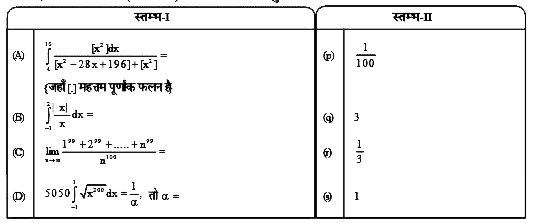माना y = f (x) एक अवकलनीय वक्र है, जो ∫x2f(t)dt=x22+∫2πt2f(t)dt को संतुष्ट करता है, तो ∫π/4−π/4f(x)+x9−x3+x+1cos2x dx का मान होगा -
0
1
2
3
The correct Answer is:C
Step by step video, text & image solution for माना y = f (x) एक अवकलनीय वक्र है, जो int _( 2) ^( x) f ( t) dt = ( x^(2))/(2) + int _(pi) ^(2) t^(2) f (t) dt को संतुष्ट करता है, तो int _( - pi // 4) ^( pi // 4) ( f ( x) + x ^(9) - x^(3) + x + 1)/( cos ^(2) x) dx का मान होगा - by Maths experts to help you in doubts & scoring excellent marks in Class 12 exams.
Updated on:21/07/2023Topper's Solved these Questions
- DEFINITE INTEGRATIONBook:ALLEN HINDIChapter:DEFINITE INTEGRATIONExercise:Exercise - 03 (सत्य / असत्य)
Explore 6 Videos
- DEFINITE INTEGRATIONBook:ALLEN HINDIChapter:DEFINITE INTEGRATIONExercise:Exercise - 03 (स्तम्भ सुमेलन)
Explore 3 Videos
- DEFINITE INTEGRATIONBook:ALLEN HINDIChapter:DEFINITE INTEGRATIONExercise:Exercise - 01 (सही विकल्पों के चुनिए एक या एक से अधिक सही उत्तर है)
Explore 9 Videos
- CONTINUITY Book:ALLEN HINDIChapter:CONTINUITY Exercise:EXERCISE -05 [B] (JEE-ADVANCED: PREVIOUS YEAR QUESTIONS)
Explore 2 Videos
- DETERMINANTBook:ALLEN HINDIChapter:DETERMINANTExercise:DO YOURSELF -9
Explore 1 Video
Similar Questions
समाकल ∫0−∞x.exdx का मान परिमित नहीं होता
View Solutionनिम्न प्रश्न में दो स्तम्भ में वत्क्व्य (statements) दिये गए है जिनका सम्मेलन (match) करना है । स्तम्भ - I(Column-I) के वत्क्व्यो को A, B, C तथा D नामित किया गया है जबकि स्तम्भ -II - (Column-II) के वत्क्व्यो को p,q, r तथा s नामित किया ज्ञात है। स्तम्भ- I (Column-I ) में दिए गए कोई एक वत्क्व्य स्तम्भ -II (Column-II ) के एक वत्क्व्य से सही सुमेल करता है।

View Solution∞∫0x(1+x)(1+x2)dx
View Solutionफलन f(x)=⎧⎨⎩e1/x−1e1/x+1जबx≠01जबx=0 का x=0 पर सततता का परीक्षण कीजिए।
View Solutionसमीकरण निकाय λx+y+z=0,−x+λy+z=0,−x−y+λz=0 का एक अशून्य हल होगा यदि λ का वास्तविक मान है
View Solutionf(x)=sinx+∫π/2−π/2(sinx+tcosx)f(t)dt
The range of f(x) is
View Solutionf(x)=sinx+∫π/2−π/2(sinx+tcosx)f(t)dt
f(x) is not invertible for
View SolutionLet f(x)=∫x3x2dtlnt for x>1andg(x)=∫x1(2t2−lnt)f(t)dt(x>1), then:
View SolutionFor any x∈R,andfbe a continuous function Let I1=∫1−cos2xsin2xtft(2−t)dt,I2=∫1+cos2xsin2xf(t(2−t))dt, then I1=
View SolutionIf f(x)=∫g(x)0dt√1+t3,g(x)=∫cosx0(1+sint)2dt, then the value of f'(π2) is equal to:
View SolutionFind the derivative of F(x)=∫x3π/2costdt
View Solutionf(x)=sinx+∫π/2−π/2(sinx+tcosx) f(t) dt then max value of f (x) :
View Solutionf(x)=sinx+∫π/2−π/2(sinx+tcosx)f(t)dt
The range of f(x) is
View Solutionf(x)=sinx+∫π/2−π/2(sinx+tcosx)f(t)dt
f(x) is not invertible for
View Solutionf(x)=1x2x∫2[t2+f(t)]dt, find f (2)
View Solution